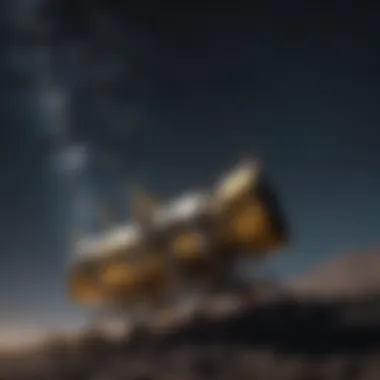Examining the Financial Implications of JWST


Intro
The James Webb Space Telescope (JWST) is more than just an astronomical marvel; it’s a financial juggernaut. The sheer scale of investment that has gone into this groundbreaking project reflects not only the ambition of its goals but also the intricate dance of various funding sources and the economic implications of deploying such an asset in space. The financial aspects of JWST bridge a wide array of topics—funding intricacies, budget allocation, and international collaboration—and raise questions on the sustainability of public investment in scientific research.
Understanding the financial dynamics surrounding the JWST involves exploring the layers of budgeting challenges, the prioritization of resources, and the weighty decisions faced by policymakers. Each financial decision made during the planning and development phases has implications, affecting not just the scientific community and its potential discoveries, but also taxpayers who will shoulder part of the financial burden. As we delve deeper, we will navigate through the pathways of funding, dissect the various economic considerations, and illustrate how these facets intertwine with the broader scientific landscape.
Prelude to the James Webb Space Telescope
The James Webb Space Telescope (JWST) stands as a monumental achievement in the realm of astronomy and space exploration. As we delve into its financial dimensions, it’s crucial to grasp why this telescope is more than just a sophisticated piece of technology; it embodies humanity’s quest for knowledge. Understanding the importance of JWST involves acknowledging its role in bridging historical advancements in designs of space observatories to today’s expectations that the scientific community has for instrumentation to explore the cosmos.
Historical Context of Space Telescopes
The journey of telescopes extends back centuries, with pioneers like Galileo igniting curiosity about the heavens. Fast-forward to the 20th century, where the launch of the Hubble Space Telescope marked a paradigm shift; it opened gateways into the universe that were simply out of reach from Earth-based observatories. The Hubble's unprecedented clarity provided insights into distant galaxies, led to the discovery of exoplanets, and reshaped our understanding of cosmic history.
However, while Hubble dazzled, its limitations soon became apparent — infrared observations were hardly its strong suit. The doorman to the universe was not fully open. This historical backdrop sets the stage for the JWST, which was line up as Hubble's successor, wishing to overcome those very restrictions and push the frontiers of astronomical knowledge further than ever before. The JWST isn’t just an upgrade, it is a new ambition, a device that aims to see the universe in dazzling detail in infrared light, thus extending our visual reach to the very dawn of time.
Vision and Goals of the JWST
With blueprints laid out for a groundbreaking telescope, the JWST aims high — really high. The primary goals orbit around the crucial desire to study the formation of stars and galaxies, to peer deeper into the atmospheres of exoplanets, and essentially to unlock the mysteries of the universe's evolution.
- Infrared Observation: The telescope's ability to capture infrared light allows it to delve into areas where the universe is cloaked in dust, revealing star formation processes that remain hidden from visible wavelengths.
- Expansive Range: Stretching back to the Big Bang era, the JWST will give researchers a glimpse thousands of millions of years into the past, effectively chronicling the birth of stars and galaxies.
- Atmospheric Studies: This jewel of technology will also scrutinize the atmospheres of distant exoplanets, detecting chemical signatures that could hint at the existence of life outside our solar system.
As we move forward, it is key to highlight that the permanence of such groundbreaking research brings with it a weighty financial responsibility. The investment in the JWST is not just about its construction and the technology it might bring; it encompasses a larger debate regarding budgetary priorities, return on investment, and the balance between immediate societal needs and the thirst for long-term knowledge. With such a monumental financial footprint, understanding where the funds come from and how they are allocated will be central to exploring the financial dimensions attached to this ambitious endeavor.
"Space telescopes are not just observatories; they are threads of human curiosity woven into the fabric of the cosmos."
In subsequent sections, we will analyze these financial dimensions, shedding light on the costs, funding sources, and the broader economic implications surrounding this venture.
Understanding the Total Cost of JWST
Understanding the total cost of the James Webb Space Telescope (JWST) is crucial, not only for grasping how funding shapes modern astronomical endeavors but also for the implications that these financial commitments have on the scientific community and taxpayers alike. By dissecting the costs associated with developing and launching JWST, one can appreciate the sheer scale of investment involved in this ambitious project. Such financial analyses often reveal insights into government priorities, public perceptions of science funding, and the expectation that arises with substantial expenditures on technology that promises to expand our understanding of the cosmos.
The implications of these financial assessments include considerations on whether such an investment yields commensurate scientific returns. As one examines JWST's funding trajectory, it becomes clear that understanding its costs isn't just about the dollars spent; it delves into the broader discourse regarding fiscal accountability in large-scale governmental projects.
Initial Budget Estimates
When discussions about the JWST's budget kick off, the initial estimates become a focal point. At inception, NASA estimated that the project would cost around $1 billion. This figure, set two decades ago, appeared manageable in the context of visionary science projects of that time. However, as any seasoned budget analyst would tell you, initial estimates often morph over time due to unforeseen challenges, technological shifts, and evolving project scopes.
From the outset, the JWST faced significant challenges. Underestimating the complexities of developing a telescope with advanced infrared capabilities compounded costs considerably. Technological advances introduced after the project's initiation also forced a reassessment of funding needs. Hence, while the $1 billion figure was a worthy start, it barely scratched the surface of the financial reality that would unfold.
Final Cost Breakdown
Fast forward to the completion of the mission, and the JWST's final cost swelled to a staggering $10 billion. This jump could raise eyebrows, but when dissected, the cost breakdown reveals various elements at play:


- Development Costs: These include expenses related to the design, assembly, and testing of the telescope, which accounted for a significant chunk of the budget. This was not merely a matter of creating a product; it encompassed years of research and innovation.
- Launch Costs: Getting JWST into orbit wasn't a simple task. Utilizing the Ariane 5 rocket alone cost hundreds of millions of dollars, highlighting how launch logistics play a role in overall expenses.
- Operational Costs: After launch, ongoing support and maintenance to ensure that JWST operates at peak performance also hold costs, underscoring that budgeting doesn't end at launch day.
Overall, the granular detailing of these aspects assists stakeholders in comprehending where money is being allocated and why the increases, while possibly alarming, became necessary to achieve the mission's ambitious targets.
Comparison with other Space Missions
When placing the JWST's financial story in context, comparing its expenditures with those of other notable space missions can be enlightening. For instance, the Hubble Space Telescope, which revolutionized our understanding of the universe, came with an estimated total cost of about $4.7 billion as of its last servicing mission in 2009. While this might seem less than JWST's final tab, one must consider the capabilities and advances offered by JWST in contrast.
In terms of complexity, the Mars Curiosity Rover, known for a target mission cost of $2.5 billion, serves as another comparison point. While each project bears its unique set of challenges and outcomes, the JWST's magnitude stands out as a testament to advancing science, even if it comes with a hefty price tag.
More than just a numbers game, these comparisons also provoke conversations about priorities in the space sector. It sparks discussions about whether the scientific community’s resources are being used wisely or if certain missions deserve greater funding due to their potential impact on humanity’s understanding of the universe.
The JWST isn't just a telescope; it's an investment in our future understanding of the cosmos.
By analyzing the total cost, one begins to understand that the JWST's budget isn't merely a ledger figure but a reflection of broader societal values, the commitment to exploration, and the essential role that government funding plays in advancing scientific inquiry.
Funding Sources for JWST
Understanding the financial resources behind the James Webb Space Telescope (JWST) is essential for grasping how such an ambitious project came to fruition. The funding sources not only highlight the financial commitment to advancing our understanding of the universe but also illustrate the collaborative nature of modern space exploration. In dissecting the funding mechanisms for JWST, we uncover how government allocations, private contributions, and international partnerships coalesce to support groundbreaking scientific endeavors. These facets underline the importance of public and private investment in a shared goal of pushing the frontiers of knowledge.
Government Allocations
When it comes to large-scale aerospace projects, government support is typically the cornerstone of funding. For JWST, the primary funding source was derived directly from the United States government, with NASA leading the charge. Over the years, the U.S. Congress has allocated significant budgets to NASA, which in turn designated a substantial portion for JWST. The initial estimates and subsequent adjustments demonstrate the critical role of political will and legislative support.
These allocations were not without scrutiny or debate. Policymakers had to balance competing priorities within federal budgets, often weighing the cost of science against immediate social needs. As the costs for JWST increased, agencies had to advocate fiercely for continued funding, showcasing the project's potential benefits in spurring technological innovation and expanding scientific knowledge.
Private Contributions
While governmental funds form the backbone of JWST's financing, private contributions have also played a notable part, albeit to a lesser extent. Some private organizations and philanthropic entities expressed interest in supporting space research, recognizing that the fruits of such investments extend far beyond the boundaries of traditional science. Often, these private actors contribute by funding specific research initiatives that align with their interests in technology advancement or education.
One noteworthy case is The Planetary Society, which actively raised awareness and funds for space initiatives, thereby enlisting public engagement and private donations. The involvement of the private sector reflects an understanding that astronomical research often leads to innovations that benefit everyday life, from improved telecommunications to breakthroughs in materials science.
International Partnerships
In today's globalized world, the collaboration between nations has become increasingly crucial in tackling complex scientific challenges. The JWST is a prime example of such collaboration. Countries like Canada and certain member states of the European Space Agency provided critical funding and components, sharing both the financial burden and the scientific rewards.
This financial interdependence fosters a spirit of cooperation, enabling nations to pool resources and expertise. Such partnerships yield benefits beyond just funding; they also facilitate cultural exchange and enhance international relationships. The success of JWST can thus be viewed not only as an American achievement but as a communal venture, knitting together a diverse tapestry of scientific talent from across the globe.
"Collaboration in space exploration is not just about sharing dollars, but about merging divergent perspectives and enhancing our collective understanding of the cosmos."
The Economic Impact of NASA Projects
The ongoing financial discourse surrounding the James Webb Space Telescope (JWST) goes beyond mere numbers and budgets. It fundamentally ties into a bigger picture involving job creation, economic stimulus, and the emergence of new technologies. Evaluating the economic impact of NASA projects is essential for understanding how investments in astronomical undertakings can increase national welfare and foster growth across multiple sectors.


Job Creation and Economic Stimulus
When we think about large-scale projects like the JWST, one important thing that springs to mind is employment. The colossal budget and intricate work needed for such a telescope ripple through the job market. According to estimates, the construction and launch phases have created thousands of direct jobs. This isn’t just about scientists and engineers; it encompasses a wider array of professions. Skilled tradespeople, administrative support staff, and suppliers all see their roles intensified.
- Direct Jobs: Personnel directly involved in the construction, design, and launch activities.
- Indirect Jobs: Workers in sectors such as manufacturing, logistics, and support services.
- Induced Jobs: A third layer of employment, arising from spending by the employees whose jobs are tied to the project.
The JWST, developed at a staggering cost of several billion dollars, has not only stimulated the local economy near the Space Telescope’s projects but also had a broader economic reach. This injects substantial economic activity into surrounding areas with considerable return on investment. When people get jobs, they spend money, which stimulates even more economic activity. Local businesses flourish when employees dine at restaurants, purchase materials, and seek entertainment.
“NASA’s expenditures provide a unique opportunity for economic growth through job creation and prosperity.”
Moreover, investments in projects like the JWST can significantly affect economies at the national level. The funds allocated for this project can stimulate technology transfer to other sectors. High-quality employment opportunities will arise from contractors delivering components needed for the telescope and from spin-off innovations.
Technological Advancements Emerging from JWST
Beyond the immediate job market boost, there is a wealth of technological advancements that emerge from the JWST. The demands of constructing a telescope designed to look deeper into the cosmos push the boundaries of technology. Innovations in this space often cascade down to terrestrial uses.
- Optics and Instruments: The telescope has necessitated advancements in optics, resulting in enhanced imaging and data analysis tools.
- Materials Science: Lightweight, durable materials developed for the JWST may have applications in other industries, potentially revolutionizing sectors like aerospace and defense.
- Software Development: The data processing software designed for JWST has significant ramifications on big data and AI technologies.
Furthermore, these technological advances also contribute to competitive advantages for companies involved in their development. Entities that have partnered in the JWST endeavor can leverage these innovations for future projects. This can result in a technological virtuous cycle where success breeds more success, leading to sustained economic growth.
This conversation about the economic impact of NASA projects does not conclude with mere monetary calculations. It illuminates how investments can yield a range of benefits that trickle through the workforce and diffuse new technologies far beyond the walls of a research facility. As we continue to dissect the fiscal dimensions of the James Webb Space Telescope, understanding its economic implications remains paramount.
Legacy and Long-term Implications
The James Webb Space Telescope stands as a monumental testament to human ingenuity and the pursuit of knowledge. Its legacy is not merely contained within its scientific expeditions but extends far beyond the fringes of the cosmos. Understanding its long-term implications requires dissecting the various dimensions in which JWST's contributions will ripple through time and shape the future.
The Interplay of Investment and Innovation
In an era where funding for science is often scrutinized, JWST serves as a compelling case study in justifying substantial allocational expenditures. The investment of $10 billion does not just translate into astronomical observations; rather, it opens doors to a multitude of advanced technologies and methodologies benefiting diverse sectors.
Scientific Contributions Expected from JWST
JWST's primary function is to gaze deeper into time and space than ever before. The scientific contributions anticipated from this telescope are profound, focusing primarily on:
- Understanding Cosmic History: It aims to observe the formation of the first stars and galaxies, offering insights into the very origins of the universe.
- Exploration of Exoplanets: The telescope will investigate the atmospheres of exoplanets, leading to milestones in our quest for extraterrestrial life.
- Study of Stellar Evolution: Its capabilities will allow astronomers to probe the life cycles of stars, from birth to demise, thus enriching our grasp of stellar phenomena.
"JWST is not just a tool; it's a time machine that can unlock the mysteries of our cosmic past."
These avenues will generate a wealth of data that researchers will sift through for years, creating a cascade of follow-up studies and potentially spawning new fields of inquiry. JWST's findings may not yield immediate applications but are sure to cast long shadows over future scientific paradigms.
Impact on Future Space Missions
The implications of JWST do not stop within the confines of its scientific contributions. This project lays the groundwork for future missions through:
- Technological Advancements: Technologies developed for JWST may find applications in various fields, including materials science and computing.
- Inspiration for New Explorations: The successes and methodologies from JWST will likely inspire future missions, both in scope and in aspiration. Projects like the Roman Space Telescope and Europa Clipper are being planned with insights gleaned from JWST’s journey.
- International Collaborations: JWST fosters partnerships among nations, signaling a collaborative future in space exploration.


Thus, the legacy of JWST is shaped not only by the scientific answers it provides but also by how it influences and inspires the next generation of space science projects. Each mission further builds upon the lessons learned, steering humanity toward an ever-expanding understanding of the universe.
Through the lens of JWST, the sky is not the limit; it’s just the beginning.
Challenges and Controversies Surrounding JWST Funding
The James Webb Space Telescope, a marvel of modern engineering, has faced not just technological hurdles but significant financial challenges and controversies as well. Understanding these issues helps contextualize the broader implications of the project, painting a fuller picture beyond just its scientific ambitions. As one dives into the complexities of this project, it's crucial to note that funding disputes can influence not just the trajectory of scientific inquiry but also public trust and future investment in science.
Budget Overruns and Management Issues
Budget overruns have long been a thorn in the side of the James Webb Space Telescope initiative. Originally projected at an estimated $1 billion, the total cost ballooned to an astonishing $10 billion. This sharp increase has drawn sharp criticism and raised eyebrows. The unavoidable question arises: how did we veer so far from the initial estimates?
Management flaws have contributed to this financial whirlwind. When projects like JWST involve numerous contractors and agencies, the risk of miscommunication and mismanagement skyrockets. Each delay not only pushes back timelines but also adds further costs, compounding existing issues.
Many blame a lack of clear accountability among organizations involved—NASA, Northrop Grumman, and others may not have operated in concert often enough, leading to costly reallocations and redesigns that could have been avoided.
“A dollar spent inefficiently today is a dollar we no longer have for tomorrow.”
Consider the deeper implications of these budget overruns. With public funding in play, the discourse moves not just into the realm of numbers, but also ethics. Is it justifiable to continue pouring tax dollars into a project that has already seen such significant increases in cost? The answer seems to sway based on who you speak with—scientists advocating for its potential discoveries or taxpayers questioning the expenditures.
Public Perception and Accountability
Public perception plays a pivotal role in the discourse surrounding funding for the James Webb Space Telescope. The skepticism surrounding the cost overruns has led to a more general mistrust of large scientific projects. Many taxpayers voice concerns about whether such significant amounts of public money are being wisely allocated.
As opinions swing back and forth, one can find both advocates who passionately discuss the importance of JWST and critics who feel that money could be better spent on immediate social issues. This complex relationship shapes a narrative fraught with tension.
To those in the scientific community, accountability and transparency become not just buzzwords but necessities. Agencies like NASA must strive to communicate openly with the public. Regular updates about budget allocations and expectations can serve as a way to bridge the widening chasm between scientists and taxpayers.
In summary, the funding challenges faced by the JWST are a microcosm of broader issues in science funding today. Budget overruns and the resulting public perception can dictate the course of innovation, risking the advancement of scientific knowledge in a tempest of financial scrutiny. By addressing these concerns head-on, perhaps there's a path forward that reconciles both ambition in space exploration and the public trust.
Ending
As we draw our exploration into the financial dimensions of the James Webb Space Telescope (JWST) to a close, it becomes clear that this project stands as both a monumental achievement in science and a financial juggernaut. The importance of dissecting the funding aspects of JWST is manifold. First and foremost, the telescope symbolizes a leap in our understanding of the universe, and the investments made reflect society's prioritization of scientific inquiry. These considerations are instrumental on multiple levels.
Reflecting on Investments in Science
Investment in science, particularly in groundbreaking projects like the JWST, is a discussion fraught with complexities. The funding allocated is not merely dollars on a balance sheet; it is an investment in the future of knowledge, innovation, and inspiration. Each dollar directed toward the JWST contributes to advancements in technology that can filter down into everyday life.
- Technological Spinoffs: Innovations designed for JWST, such as advanced imaging systems and durable materials, often find applications in other industries, from healthcare to telecommunications.
- Inspiring Future Generations: Projects of this scale captivate young minds, encouraging careers in STEM fields.
- Scientific Opportunities: The data collected will open new avenues of research, enhancing our understanding of cosmology, exoplanets, and fundamental physics.
"The pursuit of knowledge has always required investment; how we choose to allocate those funds determines the legacy we leave behind."
Future Considerations for Space Exploration Funding
Looking forward, the funding landscape for space exploration must evolve in tandem with growing ambitions and technical complexities. Policymakers and stakeholders have a responsibility to ensure that investments in astronomy and other space projects are sustainable and justified.
Several considerations stand out for the future:
- Sustainable Funding Models: As single missions become increasingly expensive, sustainable funding through multi-year budgets may provide much-needed stability.
- Partnership Opportunities: Encouraging partnerships with private entities and international organizations can leverage additional resources and expertise.
- Evolving Public Perception: It’s crucial to improve public understanding of the benefits derived from space exploration to engender continued financial support.
The future of space exploration funding is intricate and demands a thoughtful approach---one that aligns scientific aspirations with fiscal responsibility. As we reflect on the financial journey of the JWST, it’s imperative to recognize that investing in such projects is not merely a cost, but a chance to answer age-old questions about our universe and our place within it.















